See also: Timeline of Dankuk's History
The History of Dankuk (Kyomal: 亶史, Draniano: Draniasa, Draddwyr: Hanes Penru) is long, varied, and complicated; involving a tapestry of different social and ethnic groups. Generally, historians use an Era system to demark the various ages of Dankuk's history; Prehistoric (7th Century BCE - 1st Century BCE), Heroic (1st Century BCE - 458 CE), Intermediate (459 - 542), Classical (543 - 756), Medieval (757 - 1634), Dark (1634-1910), Colonial (1910-2177), Post-Colonial (2177-3608), and Contemporary (3608 - Present). The following article is a brief overview of all eras.
Prehistoric Age[]

Left: Map of the most commonly accepted Draddwyr eastern immigration theory
Right: Map of the Kyo immigration hypothesis. The Kyo entered the peninsula, and upon reaching the Pan River Valley split upon into a nomadic northbound group and a sedentary southern group.
Early human settlement of the Dranian Peninsula is believed to have began around the 23rd Century BCE, but there remains little information regarding the cultural and ethnic identities of the early settlers. By the 7th Century BCE, possibly congruent to the invasion by Draddwyr tribes from Eastern Dovani. Kyo nomads also began to enter the peninsula shortly after the Draddwyr, some settling around the . These Kyo people would go on to start the Jumun Period which saw the development of sedentary societies, agriculture, and pottery.
Heroic Age[]
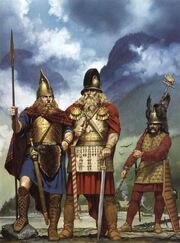
Artistic representation of the Draddwyr Glasafon Culture.
WIP, do not delete
Intermediate Period[]
WIP, do not delete
Classical Age[]
WIP
Medieval Period[]
WIP, do not delete

Selucian and Egelian Colonization[]
During the Renascentia the states of the Selucian islands began establishing colonial outposts in Dovani, following the path of Luthori. In 1633 Baeguk was forced to become a Selucian protectorate, and after the unification of Selucia it was brought under the contol of the Selucian Empire. In 1869, King Jeong-u was forced to abdicate and the Kyo nation was annexed by Selucia. In place of Baeguk, Selucia established the Province of Drania, with its capital at Castellón (modern day Keosen).
During the period of Selucian colonization Drania was under the control of its colony of Egelion there was massive immigration of Egelian citizens to the peninsula. These colonial Egelians over time transformed into a new ethnic group as they established their own unique identity. And a number also bred with the Kyo, further emphasizing the difference between them and the Egelians. These Dranianos became increasingly detached from Egelion, beginning in the 19th Century. From this growing resentment, there were numerous revolts throughout the 20th and 21st Centuries. When Egelion gained independence from Selucia in 1905 as a result of the North Seleyan Wars, it retained colonial control over Drania.
Dranland[]
Great unrest persisted in Drania, but it was not until 2177 that the peninsula finally gained independence from Egelion. During the early autumn of that year, the Republic of Dranland was proclaimed and in March of the following year, democratic elections were conducted, electing Maria Wallstott (Conservative Party of Dranland) as the first President of a free and democratic Dranland.
The First Republic lasted until the 2420s, at which time the Dranian Imperium was established; and in the 2540s, replacing the Imperium was the Second Republic of Dranland, known officially as the Respublica Dranii. This republic collapsed following a military coup in 2840 after over a decade of ethnic tensions and governmental corruption. The military junta, led by General Jakov Wolfseye, was relatively ineffective and was ousted by a movement led by Lady Godiva Wittenfeld of the theocratic Party of the Light. Lady Wittenfeld, a major saint of the Universal Church of Terra (UCT) transformed Drania into a theocratic state under the UCT; the Theocratic Republic of Dranland.
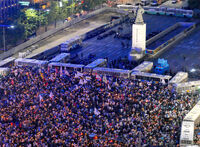
Gongmangdo during the Seung Revolution.
In time, the theocratic republic transformed into a kingdom after an agreement was made between the ruling clergy and the increasingly powerful Santiago Family. In 2873, the nation became a theocratic monarchy led by King Alejandro I of the House of Santiago. Just like its preceding regimes, the theocracy was plagued by ethnic tensions between the Kyo, Dranianos, and Draddwyr. In the 2960s, the Gao-Showa Imperial Revolutionary Front formed as the only opposition to the theocratic regime, and in 2964, massive Kyo nationalist protests turned into a nationwide revolution, the Dranian Seung Revolution. King Rodrigo I was forced to abdicate and flee to Hulstria, and Dong Young Sung became ruler of the revolutionary government of the Holy Kingdom of Deulatoji.
Pursuing Pan-Dovanist goals, the nation united with the Second Sekowan Empire. Having occurred in the midst of the Great Sekowian War, unity was only on paper, and when the Sekowan Empire was destroyed in 2980, Deulatoji liberalized and became a democratic parliamentary democracy, known officially as the Enlightened People's Republic of Deulatoji.
The new governmental system was short-lived and a new monarchy was established by the House of Santiago, which had returned from exile in Hulstria. Briefly, the monarchy was deposed from 3123 to 3183, during the Third Republic. With the foreign intervention of Hulstria and the International Monarchist League in 3182, the controversial House of Santiago was returned to power and the Kingdom of Dranland was reestablished by 3184.
In the 3280s, in an initiative led by the republican Rally for the Republic, the House of Santiago lost much of its legitimacy and was forced out of the monarchy. A provisional head of state position was created and there began debates for reforming the monarchy. The duchess Ceridwen Cadwallader was elected to the position and eventually became Queen of Dranland. In June 3336, the Rally for the Republic and Unity successfully abolished the monarchy completely and the Fourth Republic of Dranland was established.
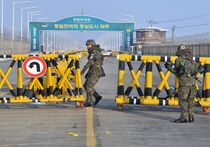
The Fourth Republic existed for 241 years, before it collapsed during the turmoils of the 3570s. During this time the highly unpopular government of the Draddwyr extremist Morganna Cadfeal refused to step down after President Sun Ryoji, with the support of parliament, declared control of the government. These tensions were further aggravated by over a decade of renewed ethnic conflict, particularly among the Kyo and Draddwyr. In government, neither side, Sun or Cadfeal, held full power and the military, led by General Joel Cubrero, carried out a coup on 10 October 3572. Between 3572 and 3577 the nation was divided between the Fifth Republic, led by General Cubrero, and the Dranish Free State, led by President Sun, in Elbian. Cubrero was eventually deposed by his own government officials and leaders of the two states negotiated reunification, establishing the Sixth Republic of Dranland.
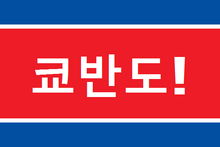
Flag of the Kyo Revolution.
Kyodae Dictatorship[]
While the nation celebrated its reunification, there remained strong nationalistic sentiments among the Kyo. The Dranish Free State, while not a "Kyo nation," gave many Kyo nationalists a taste of independence. And to many, the Free State was perceived as a free Kyo state due to the domination of the Kyo in its government.
Through the 3580s and leading into the 37th Century, the political and social scene of Dranland had become very subdued. For the first time in many decades the nation was at its most stable point. However, during this same time period a faction of Kyo ultranationalists slowly organized, first under the banner of the Revolutionary Committee of the Kyo Defense Force (despite the name, it was not affiliated with the Kyo Defense Force [KDF]). By the end of the 3590s the group, led by Lee Dong-seung, changed its name to the Kyo Revolutionary Society (KRS).
Lee and a handful of other nationalists had been elected to the Dranish Parliament, but they wielded no power and were largely dismissed by the public. But after years of underground planning, Lee and his secret partner in government, the Minister of Defense Lu Min-wei, the KRS initiated the Great Kyo Revolution of 3608. Thousands of Kyo nationalists took to the streets, and with the assistance of loyalists in the military, overthrew the Dranish Government, led by Taoiseach Park Taeyung of the KDF.
The revolutionaries quickly consolidated power under the newly declared president, Lee Dong-seung. And in the months that followed the new regime pursued various policies to enact the "re-Kyoification" of the peninsula. Among these policies were the movement of the Draddwyr to the Commonwealth of Northern Dovani, which was officially acknowledged by President Lee as the Draddwyr Homeland. Additionally there were restrictive laws set upon the non-Gao-Showa population, including a one-child policy and a lesser form of citizenship (officially called "honorary citizenship).
While holding absolute power, President Lee removed himself from the position of head of state by officially establishing the free Kyo nation as a monarchy, known as the Kingdom of Dankuk. Initially King Yongchae was going to be crowned, however, Yongchae, a former politician of the KDF, disapproved of Lee and refused to be king. As a result Yongchae was forced to abdicate and Lee's government coerced the rest of the royal family to cooperate and Crown Prince Jongki was crowned as the first King of Dankuk.
The free Kyo state, firmly dominated by Kyodae, labeled itself as a democracy, but in practice it was an authoritarian one-party state. While this reality existed, for most of the Kingdom's existence there was little pro-democracy unrest, except in its final years. During the Kyodae dictatorship there was considerable stability and economic growth, as well as greatly increased foreign relations with states such as Indrala.
Neo-Cheng Socialism[]
Not long after the election of the nation's first female president, Song Miyako, a movement emerged seeking the restoration of Cheng Socialism, the ideology which guided the Dranian Cheng Revolution of 2694.

Day of Rage protesters at Gongmangdo University.
In its early years, this movement took on a major role as a pro-democracy organization as it struggled to gain approval to participate in the regulated national elections. As the Kyodae government began to stall in recognizing the Cheng socialists, protests erupted throughout the nation, particularly in Gongmangdo. This unrest of 3679, which started in an event known as the "Day of Rage," saw major violence unlike any before and protesters had even occupied the campus of Gongmangdo University.
Controversially, President Song called the military into Gongmangdo and tanks were positioned at sites such as the Royal Assembly. Soon after the protests died down and order had seemingly been restored. And in the autumn of 3679, at the Kyodae's Third Political Conference for the election of the president, it was also decided to grant the Cheng socialists recognition for their party.
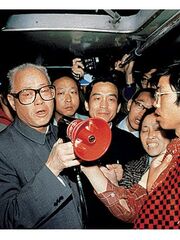
Joon Moon, Cheng Socialist leader, outside parliament following victory in 3685.
When elections occurred for parliament in 3685, huge controversy emerged as the Cheng socialists won in a landslide. While they had taken the majority, control of the central government offices still remained with Kyodae and President Sun Jonghyun despite a claim of control by the new majority. In October, President Sun ordered tanks to surround the parliament in midst of major rioting throughout Gongmangdo. As this all occurred, the Royal Family, led by King Jinkyun, fled the city and went into hiding.
Throughout early October there were numerous clashes between supporters of Kyodae and Cheng socialists. However, Kyodae was weakening and on 5 October the party officially split. Kang Yoonseok, one of the few government ministers to give up his position following the election, established the Pyeongreo Faction of the Kyo Defense Force. This faction of Kyodae sought to end the violence and to work peacefully with the elected Cheng socialist government. By the summer of 3686 the last of the Kyodae resistance was ended. Two years later, the new dictatorship, now dominated by the Cheng socialists, ordered for presidents Sun Jonghyun and Song Miyako to be put to death for their roles in the 3685 resistance.
By 3688, the Cheng socialist government had effectively established as even more strict and oppressive dictatorship than the previous. Around this same time, Indrala began to act upon the terms of the Treaty of Soleynka, which had transferred new colonial territories to Dankuk. Under its terms, if the Dankuk monarchy were to be deposed, Indrala could reclaim all of Dankuk's colonial territory. This reclamation quickly escalated into an all out war between the two former allies.
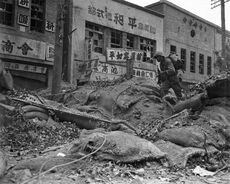
Section of Gongmangdo in ruins from Indralan invasion.
In 3689 the Kyo-Indralan Revolutionary War began as Indralan forces made their landing in Eljang and advanced towards Gongmangdo. After a major late summer battle in Melang, a stalemate emerged in the region. This lasted until the spring of 3690 when Indrala opened a second front by landing in Hyonggi. With defenses spread out Indrala was able to march on Gongmangdo, resulting a the largest battle of the war in the autumn of 3690. This battle saw widespread destruction throughout Gongmangdo, including the destruction of major sites such as the Royal Assembly, Beonyeongsalm Palace, and Gongmangdo University. Deaths were in the thousands and the city was utterly devastated; and despite this outcome, it was a military victory for the Cheng socialists.
After the Battle of Gongmangdo, a new stalemate emerged and there was little progress for either side. However, Dankuk was quickly weakening as it became confronted by the actions of the Taegeuk Tigers, a pro-democracy freedom fighter group. Unknown at the time, the Taegeuk Tigers were affiliated with the Pyeongreo Faction, which had been invited to compose a civilian element of the Cheng socialist's wartime cabinet. In 3696 a series of terrorist attacks were launched against government facilities and soon after a full-scale coup was initiated by the Pyeongreo Faction. An interim government was established under former Foreign Minister Kang Yoonseok and negotiations of peace began with Indrala.
Post-War Dankuk[]
The interim government of Kang Yoonseok came to an end in 3702 when the Great Kyo Empire was officially established. Styled as a democratic parliamentary constitutional monarchy, this empire became the first democratic Kyo state. Kang and his newly formed political party, the Sunrise Party, won the first elections. As with his term as interim leader, Kang quickly returned to overseeing a massive national reconstruction project to negate as much of the war's effects on Dankuk.
Gongmangdo's destruction had a hugely negative effect on the economy and millions were displaced from their homes. By the time of the 3702 elections stability had been brought to Gongmangdo, but the city was still very much a shell. Under the newly established empire, the national capital was moved to Seongtaek, which had been much less affected by wartime destruction. At this point in time, Seongtaek had also become the largest city due the war.
Progressing through the 38th Century, major focus was put into reconstructing Dankuk's post-war infrastructure and economy. One of the biggest successes was the establishment of a nationwide high-speed railway system by the government-owned Dankuk Railway Corporation (Danrail). President Daiki Delgado celebrated the opening of the rail system in 3766 by going on a nationwide tour on the inaugural train.
The Buchan Empire[]
During early 3779, the increasingly withdrawn and regressive governing style of President Lee Jeongsung led to a severe economic depression, followed by widespread racial insurrection and violence. In mid-3779, Emperor Ryōta refused to intervene in the ever growing crisis, and continued delegation of his executive powers to President Lee's administration. The failure of the Emperor to act allowed the crisis to develop into a nationwide anarchy movement. By the fall of that same year, the government of President Lee and his Sunrise Party had collapsed, and the single-party state they had established was virtually destroyed.
At this point, the Draddwyr-led movement to oppose the Sunrise Party, under the leadership of Northern Dovani noble Hayden William van Buchan III and his Imperial House of Buchan, formally organized their efforts into the Dranland Restoration Alliance. It was the belief of the Alliance that the most recent Kyo dictatorship had utterly failed the citizens, and was direct threat to the future of Dankuk. They vowed that under their leadership, through the restoration of Dranland, that such a crisis would never happen.
In November of 3779, the private defense force of the Imperial House of Buchan, known as the Valorian Guard, conducted a covert operation to secure the Beonyeongsalm Palace in the City of Gongmangdo, placing Emperor Ryōta and the remaining royal members of the House of Ryeo into protective custody. Immediately thereafter, the Valorian Guard, with the aid of military units loyal to the Alliance, quickly secured the major cities of Gongmangdo, Iglesia Mayor, and Seongtaek. Following the restoration of national law and order, most remaining units of the Dankuk Armed Forces returned to duty under the command of Valorian Guard leadership.
That December, the Dranland Restoration Alliance stood unopposed in the parliamentary elections; winning all 300 legislative seats. Upon convening the new parliament, the first official act was to pass a motion of confidence in favor of the newly proposed Buchan Government to be led by Hayden William van Buchan III as the Head of Government.
Early the next year, the National Assembly of Dankuk announced its unanimous support for the implementation of the Imperial Constitution of 3780. The Imperial Constitution was ratified in December 3780, Dankuk was officially reformed into the Dranland Empire, and Hayden William van Buchan III was crowned as the new Emperor of Dranland.
Emperor Hayden ruled the newly reformed Dranland for more than nine years from December 3780, until February 3790. The first half of the new Emperor's reign was defined by national growth and stability. From 3780 to 3785, Buchan Loyalist held every in the parliament. The second half of Emperor Hayden's reign, unfortunately, was known for opposition obstructionism, Sun Rise-party era violence, and vengeful Kyo nationalism. In 3785, Buchan Loyalist retained a plurality of parliamentary seats; however, two radical Kyo national parties won a majority of the seats. This allowed the Kyo nationalist to establish a new cabinet led by Yi Eunseok, an ally of former President Lee Jeongsung.
The final four years of the Dranland Empire were spent as a civil war, with Emperor Hayden and the Buchan/Dranland Loyalist opposing President Yi and his rising Kyo forces. Numerous Kyo-majority units of the Dranland Armed Forces soon aligned with the President, and fought against the Emperor. In 3786-3787, numerous nations began supporting the return of Kyo nationalism by providing significant military and economic aid. By May 3788, the Valorian Guard and Buchan Loyalist military forces had lost control over most of the nation, except the heavily fortified and secured region of Ulbrach, home to the Buchan's imperial capital of Iglesia Mayor.
In January 3790, after the authorization of an execution warrant by the Yi Government, the members of the Imperial House of Buchan, including Emperor Hayden, fled Dranland while it was still safe to do so. The absence of the Emperor's leadership caused a rapid decrease in Buchan Loyalist morale. During the summer of that year, the Valorian Guard withdrew all of its military assets from Dranland, experiencing modest losses. Upon the the withdrawal of the Valorian Guard, most Buchan Loyalist either escaped the country or were captured by Kyo forces.
Post-Buchan Imperialism & Septembrism[]
Following the end of the Buchan-led empire, restoration of the Dranian culture and government began with the enactment of the Kyo Reclamation Constitution in February 3790, when all imperial titles were removed and the Ryeos returned to titling themselves as kings. During the early 3790s, until the 3820s, life in Dankuk was quite stable. Despite this, unprecedented political revolution occurred in 3828 when minority groups with associations to Hulstrian Septembrism took control of the government and quickly moved to eliminate the monarchy and establish a Western-style liberal democracy. These events were immediately followed by a new emergence of ethnic radicalism by Draddwyr populations who sought to take advantage of the situation and return to Dankuk. Society became increasingly destabilized as many new groups emerged to either challenge or support the "Union of Dankuk," the Septembrist governmental system.
Initially Kyo opposition organized with Jeong Jin Ji, a controversial professor from Kwangyi University, and his National Political Union (NPU) (Guglig Jeongchi Yeonhab). Later more Kyo opposition would emerge, most significantly the Dankuk National Union (DNU), which enjoyed the backing of King Jongki VI. The DNU was actually an electoral alliance of four political parties of varying ideology, but that all sought a restoration of the pre-Septembrist constitution. Led by Yoo Donghyun of New Dawn, the DNU established itself as led extreme than the NPU and it opened up serious dialogue with Unionist parties. In the 3838 elections the DNU saw a gain of 133 seats, and while not enough to form a government, it began to slowly shift power away from the Septembrists.
Over the next decade the pro-Union parties began to fracture, split, and diminish in power. In their place the various restorationist parties of the DNU, as well as the Social Democratic Movement (SDM), took over. In the 3850 elections the coalition of the DNU and SDM gained enough votes to form a government under Yoo Donghyun, finally replacing the Septembrist coalition led by Yang Sung-nam since 3834.
Kyo Reconquest and the Formation of Dankuk as a Nation-State[]
Six years after the formation of a restorationist government the Union of Dankuk was officially dismantled and the kingdom was brought back along with the pre-Septembrist constitution. Later that year, Jongki VI announced he would abdicate in favor of his son, Choesun. This accompanied a declaration that the Great Kyo Empire would also be restored and that Choesun would be the first emperor of the new Kyo empire.
In 3857 the Great Kyo Empire joined the Mikokuzin Union, a multinational union of Dovanian nations. At the same time, the common currency, Bu (布), was adopted as Dankuk's official currency. The Empire was growing increasingly confident and in 3868 Emperor Choesun I reasserted claims over Kazulia, known as Jjeokuk, and he declared himself President of Dankuk. From 3868 to 4011 the tradition would become that the emperor also hold the presidential office, effectively making Dankuk an absolute monarchy. As the century ended, numerous other nations in the Union fell to liberal revolutions, and even Indrala was increasingly unstable. Declaring itself the last stable Mikokuzin state, Dankuk left the Union in 3905.
After a long period of calm, the status quo was disrupted by the emergence of a major opposition party, the National Democratic Congress (NDC) in the early 4000s. The NDC ultimately overpowered the Ryeo-backed political party that had governed for over a hundred years. Emperor Seojun and others in the royal family were sympathetic to reform and the opposition party's rise was accepted as legitimate. However, while the royal family left government, other segments of it, led by General Choi Youngsoo, refused to hand over power. This led to a coup attempt in 4011 led by General Choi that, while ultimately failing, resulted in the assassination of Seojun, the Crown Prince, and the NDC party leader.
Following the attempted coup of 4011, the government embraced liberal reform and reestablished parliamentary democracy in Dankuk. The monarchy also voluntarily removed itself from direct political involvement, returning to a symbolic position.
Democratic People's Republic[]
A Democratic People's Republic was briefly installed in the 4760s. It saw the return of Kyo nationalism and animosity with foreign powers. Ultimately mistakes and diplomatic tension culminated into the Kyo-Kazulian Crisis; which was resolved when the military removed the government from power and made peace with Kazulia. Shortly thereafter; protests began and the DPRK collapsed.
Third Federation[]
After the DPRK's collapse; power was handed to liberals. Shortly after; the Third Dranian Federation was proclaimed in 4746. For most of it's existence the Federation was stable; a free liberal parliamentary republic with a solid government structure. Civil liberties were guaranteed; and a a biunique and autonomous federalism was in place.
But starting in the early 50th century; economic woes in combination with government policy created an incredibly tense situation in the Federation. Though a moderate socialist government was in place; it began to cut ties with the left wing and moved to the center; siding with the Taegeuk Alliance. The new constitution would also give the powers to limit political extremism. Everything came to a head on August 8; when the Premier declared that Kang Jae-Geun; the Communist Chairman; would be removed from office in fear of him inciting revolts. This led to the August Revolution; in which pre-existing worker's councils fully seized power in an armed uprising under the KCP-M; now the CPRU.
Modern UCCR[]
Early UCCR and the Civil War (4929-4930)[]
Following the August Revolution; the First Congress of the Rowis was immediately convened in the then Seongtaek Great Library and established the basic government of the UCCR as well as the Red Army. On August 21, 4929; the UCCR was formally declared at a Founding Ceremony; though legally it had been in existence since August 15. Meanwhile; paramilitary and dissident military figures began to organize resistance to the UCCR; in particular the Black Flag Leagues.
On August 23, as refugees arrived in the Southern city of Gongmangdo; there was proclaimed a Provisional Government of the Dranian Federation. A Council was formed; and the Black army was organized and took control of the Southern provinces.
The Dranian Civil War finally began on August 25; as the Black Army began to siege the strategically important city of Yonseo in Myeoggi.
Immediate Post War Period (4930-4933)[]
The UCCR reformed after the war; granting amnesty to low-level enemies of the state and allowing for greater freedoms following the end of the rationing system. Kyoseon was left a mess; and much of the nation was devastated. 4933's 5-Year Plan began to revitalize the economy; and by 4936 Rowiet society had cemented a new peace. Though on paper economic growth was much lower than the Federal Era; wealth inequality had essentially disappeared and people had control over most day-to-day production. The national economy was lower; but the standard of living on average rose dramatically.
Songun Era and Nuclear Proliferation (4933-4945)[]
Beginning in 4932, the Rowiet government began to fear for it's existence as multiple foreign governments increasingly threatened reprisal, disapproval, and even prospects of invasion. A policy of Military-First was laid out, and by 4932 the UCCR began seriously considering the manufacture of Weapons of Mass Destruction. The Rowiet Nuclear Program was approved in 4934, and more than a decade of work began on acquiring both a working atomic and hydrogen bomb, as well as a trackable ICBM with a 8,000 ri range.The UCCR detonated it's first atomic bomb in 4940. However, WMD efforts took a massive toll on civilian economy, light industry, and popularity of the government. It is estimated that at one point the project cost upwards of 25% of all government spending and budget, and massive resources were pulled to create a bomb.
The Red Thaw and Liberalization (4945-)[]
4945 would see the end of the Maerang project and general liberalization, in the social, political, and even economic arenas.
